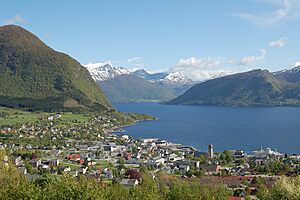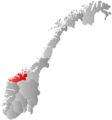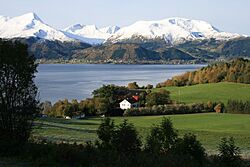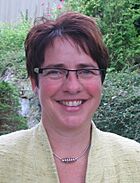Volda facts for kids
Quick facts for kids
Volda kommune
|
|||||
|---|---|---|---|---|---|
|
Municipality
|
|||||

View of Volda and the Voldsfjorden
|
|||||
|
|||||

Volda within Møre og Romsdal
|
|||||
| Country | Norway | ||||
| County | Møre og Romsdal | ||||
| District | Sunnmøre | ||||
| Established | 1 Jan 1838 | ||||
| Administrative centre | Volda | ||||
| Area | |||||
| • Total | 876.85 km2 (338.55 sq mi) | ||||
| • Land | 833.63 km2 (321.87 sq mi) | ||||
| • Water | 43.24 km2 (16.70 sq mi) 4.9% | ||||
| Area rank | #132 in Norway | ||||
| Population
(2023)
|
|||||
| • Total | 10,960 | ||||
| • Rank | #105 in Norway | ||||
| • Density | 13.1/km2 (34/sq mi) | ||||
| • Change (10 years) | 8.9% | ||||
| Demonym(s) | Volding | ||||
| Time zone | UTC+01:00 (CET) | ||||
| • Summer (DST) | UTC+02:00 (CEST) | ||||
| ISO 3166 code | NO-1577 | ||||
| Official language form | Nynorsk | ||||
| Created as | Formannskapsdistrikt in 1838 | ||||
|
|
|||||
Volda is a municipality in Møre og Romsdal county, Norway. It is part of the Sunnmøre region. The main town and administrative centre is the village of Volda. Other villages in the municipality include Dravlaus, Fyrde, Straumshamn, Leira, Bjørke, and Grodås. Volda is located about 50 kilometers (31 miles) south of the town of Ålesund.
Volda covers an area of 877 square kilometers (339 sq mi). This makes it the 132nd largest municipality in Norway. With a population of 10,960 people, Volda is the 105th most populated municipality. The area has about 13 people per square kilometer (34 per sq mi). Its population has grown by 8.9% in the last 10 years.
Contents
About Volda
The municipality of Volda was first created on 1 January 1838. Back then, it was called Volden. It included the areas of Ørsta and Dalsfjord.
Over the years, Volda's borders changed. On 1 August 1883, Ørsta became its own municipality. This left Volden with 3,485 people. In 1918, the name was officially changed from Volden to Volda.
On 1 July 1924, Dalsfjord also became a separate municipality. Volda then had 4,715 residents. Later, in the 1960s, many municipalities in Norway merged. On 1 January 1964, Dalsfjord and Volda joined together again. The new Volda municipality had 7,207 people.
A big change happened on 1 January 2020. The nearby municipality of Hornindal and parts of Ørsta (the Bjørke and Leira areas) merged with Volda. This made Volda much larger.
What's in a Name?
The name Volda comes from the Voldsfjorden. The old Norse name for the fjord was Vǫld or Valdr. The exact meaning of the name is not certain. It might come from a word meaning "gush" or "roar." It could also mean "wave," similar to the German word "welle" for wave.
Volda's Coat of Arms
A coat of arms is a special symbol for a place or family. Volda has had two different coats of arms. The first one was used from 1987 until 2020. It showed a silver pen nib pointing downwards on a blue background. This design was chosen to show Volda's long history of education. Volda had the first secondary school outside of a major city in Norway.
The current coat of arms was approved in 2019. It started being used on 1 January 2020, when Hornindal and parts of Ørsta joined Volda. This new design has a silver pen nib in the middle, just like the old one. But now, it also has two silver scythes on each side, all on a blue background. The scythes were taken from Hornindal's old coat of arms. Hornindal was known for its many smiths who made scythes.
Churches in Volda
The Church of Norway has six parishes, or local church areas, in Volda. These churches are part of the Søre Sunnmøre deanery. This means they are part of a larger church district.
| Parish | Church name | Location | Year built |
|---|---|---|---|
| Austefjord | Austefjord Church | Fyrde | 1773 |
| Dalsfjord | Dalsfjord Church | Dravlaus | 1910 |
| Hornindal | Hornindal Church | Grodås | 1856 |
| Kilsfjord | Kilsfjord Church | Straumshamn | 1974 |
| Storfjorden | Bjørke Church | Bjørke | 1919 |
| Volda | Volda Church | Volda | 1932 |
Volda's Geography
Volda is known for its beautiful fjords and mountains. The main fjord is the Voldsfjorden. It has smaller branches like the Austefjorden, Kilsfjorden, and Dalsfjorden. The area is also very mountainous, especially to the southeast of the fjords. These mountains are part of the Sunnmørsalpene. The tallest mountain in Volda is Eidskyrkja, which is 1,482 meters (4,862 ft) high.
Volda shares borders with several other municipalities. To the southwest and west, it borders Vanylven Municipality. To the west, it borders Herøy and Ulstein (only by sea). Ørsta is to the north and east. To the south, Volda borders Stryn and Stad in Vestland county.
The main population center is the village of Volda. Other important villages include Mork, Ekset, Folkestad, Fyrde, Steinsvika, Lauvstad, Bjørkedal, Grodås, and Straumshamn. Some other famous mountains in Volda are Hornindalsrokken, Kvitegga, and Jakta.
Climate in Volda
| Climate data for Volda | |||||||||||||
|---|---|---|---|---|---|---|---|---|---|---|---|---|---|
| Month | Jan | Feb | Mar | Apr | May | Jun | Jul | Aug | Sep | Oct | Nov | Dec | Year |
| Mean daily maximum °C (°F) | 0 (32) |
1 (34) |
3 (37) |
5 (41) |
10 (50) |
13 (55) |
14 (57) |
15 (59) |
11 (52) |
8 (46) |
3 (37) |
1 (34) |
7 (45) |
| Daily mean °C (°F) | −1.5 (29.3) |
−1 (30) |
0 (32) |
2 (36) |
7 (45) |
10 (50) |
11 (52) |
11.5 (52.7) |
8.5 (47.3) |
6 (43) |
1 (34) |
−1 (30) |
4.5 (40.1) |
| Mean daily minimum °C (°F) | −3 (27) |
−3 (27) |
−3 (27) |
−1 (30) |
4 (39) |
7 (45) |
8 (46) |
8 (46) |
6 (43) |
4 (39) |
−1 (30) |
−3 (27) |
2 (36) |
| Average precipitation mm (inches) | 188 (7.4) |
146 (5.7) |
154 (6.1) |
100 (3.9) |
77 (3.0) |
95 (3.7) |
117 (4.6) |
136 (5.4) |
238 (9.4) |
237 (9.3) |
218 (8.6) |
237 (9.3) |
1,943 (76.4) |
| Average precipitation days | 25 | 22 | 22 | 19 | 16 | 17 | 21 | 22 | 26 | 25 | 25 | 27 | 267 |
| Mean monthly sunshine hours | 14 | 39 | 86 | 136 | 200 | 197 | 171 | 151 | 80 | 58 | 28 | 0 | 1,159 |
| Source: World Climate Guide | |||||||||||||
Culture and Education
Volda is well-known for its strong cultural and academic traditions. In the 1800s, a private library at Egset was the first of its kind in a rural area of Norway. It even inspired the famous Norwegian linguist Ivar Aasen.
One of the most important places in Volda today is the Volda University College (HVO). It is one of Norway's 25 university colleges. About 3,000 students attend HVO. The college specializes in training teachers, animators, and journalists.
Volda's focus on animation has attracted many animation companies. Their work is shown at the annual Animation Volda Festival, which started in 2007. HVO also hosts the yearly Norwegian Documentary Film Festival (DOKFILM), which began in 1997.
Volda also hosts the national ski festival X2 every April. The Volda TI sports club has a football (soccer) team. Their home field is Volda Stadion. The team has played in various leagues for many decades.
Public services are a big part of Volda's economy, making up almost 50% of jobs. This is because of the many students and a county hospital. Industry and agriculture are also important. The area of Bjørkedalen is famous for its tradition of building wooden boats.
You can visit the Sivert Aarflot Museum at Ekset in Volda. The film Troll Hunter (2010) also features Volda and its surroundings.
Getting Around Volda
The Ørsta–Volda Airport, Hovden is located in the neighboring municipality of Ørsta. It is just north of Volda village. The European route E39 highway passes through Volda on its way to the city of Ålesund.
Because Volda has many fjords, ferries are important for travel. Both Lauvstad and Folkestad are connected to Volda village by ferry. In 2008, the underwater Eiksund Tunnel opened. This tunnel connected Volda and Ørsta to the municipalities of Ulstein, Hareid, Herøy, and Sande. It is one of the deepest undersea tunnels in the world.
The Kviven Tunnel was finished in 2012. It connects Fyrde to the village of Grodås to the south. This tunnel helped the old Hornindal Municipality join Volda in 2020.
Famous People from Volda
Many notable people have connections to Volda:
- Martin Ulvestad (1865–1942), a Norwegian-American historian and language expert.
- Peter Olai Thorvik (1873–1965), a blacksmith, fisherman, banker, and politician.
- Inger Hagerup (1905–1985), a well-known author, playwright, and poet who lived in Volda.
- Dag Frøland (1945–2010), a comedian, singer, and impersonator.
- Ottar Grepstad (born 1953), a Norwegian writer who lives in Volda.
- Olav Rune Ekeland Bastrup (born 1956), a Norwegian writer and historian.
- Ragnhild Aarflot Kalland (born 1960), a local politician and mayor of Volda from 2003 to 2011.
- Frode Grodås (born 1964), a football (soccer) goalkeeper who played for many clubs and for the Norwegian national team.
- Simone Eriksrud (born 1970), a musician, composer, and lead singer for the band D'Sound.
- Asbjørn Blokkum Flø (born 1973), a Norwegian composer, musician, and sound artist.
- Beate S. Lech (born 1974), a jazz singer and lead singer of Beady Belle.
- Erlend Slettevoll (born 1981), a Norwegian jazz pianist.
- Jon Georg Dale (born 1984), a politician and former government minister.
- Ørjan Håskjold Nyland (born 1990), a football (soccer) goalkeeper who has played for many clubs and for the Norwegian national team.
Images for kids
See also
 In Spanish: Volda para niños
In Spanish: Volda para niños












